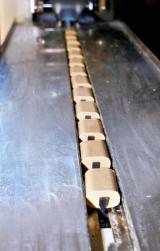Soap and Detergent Manufacturing Effluent Guidelines
EPA promulgated the Soap and Detergent Manufacturing Effluent Guidelines and Standards (40 CFR Part 417) in 1974-1975. Part 417 covers direct and indirect dischargers. The Effluent Guidelines and Standards are incorporated into NPDES permits for direct dischargers![]() direct dischargerA point source that discharges pollutants to waters of the United States, such as streams, lakes, or oceans. and permits or other control mechanisms for indirect dischargers
direct dischargerA point source that discharges pollutants to waters of the United States, such as streams, lakes, or oceans. and permits or other control mechanisms for indirect dischargers![]() indirect dischargerA facility that discharges pollutants to a publicly owned treatment works (municipal sewage treatment plant). (see Pretreatment Program).
indirect dischargerA facility that discharges pollutants to a publicly owned treatment works (municipal sewage treatment plant). (see Pretreatment Program).
- What is the Soap and Detergent Manufacturing Industry?
- Facilities Covered
- BOD7 Effluent Limitation
- Rulemaking History
- Additional Information
What is the Soap and Detergent Manufacturing Industry?
Industry facilities manufacture soap, synthetic organic detergents, inorganic alkaline detergents, or any combination. Crude and refined glycerine from vegetable and animal fats and oils are also included.
Excluded from Part 417 coverage are establishments primarily engaged in manufacturing shampoos or shaving products and synthetic glycerine. Also excluded are specialty cleaners, polishing, and sanitation preparations.
Wastewater is generated by steam pretreatment, soap boiling, equipment cleanouts, scrubber waters, scrap reclamation, condensers, still bottoms, and leaks and spills.
These activities are included within NAICS code 325611, Soap and Other Detergent Manufacturing.
Note: The NAICS listing is provided as a guide and does not define the coverage of the Soap and Detergent Manufacturing category. For precise definitions of coverage, see the applicability sections in 40 CFR Part 417.
Facilities Covered
The regulation is organized into 19 subcategories:
- Soap Manufacturing by Batch Kettle
- Fatty Acid Manufacturing by Fat Splitting
- Soap Manufacturing by Fatty Acid Neutralization
- Glycerine Concentration
- Glycerine Distillation
- Manufacture of Soap Flakes and Powders
- Manufacture of Bar Soaps
- Manufacture of Liquid Soaps
- Oleum Sulfonation and Sulfation
- Air-SO3 Sulfation and Sulfonation
- SO3 Solvent and Vacuum Sulfonation
- Sulfamic Acid Sulfation
- Chlorosulfonic Acid Sulfation
- Neutralization of Sulfuric Acid Esters and Sulfonic Acids
- Manufacture of Spray Dried Detergents
- Manufacture of Liquid Detergents
- Manufacture of Detergents by Dry Blending
- Manufacture of Drum Dried Detergents
- Manufacture of Detergent Bars and Cakes
BOD7 Effluent Limitation
Biochemical oxygen demand (BOD) is a measure of the oxygen-consuming properties of organic matter. Water with a high BOD indicates the presence of decomposing organic matter and subsequent high bacterial counts that degrade its quality. BOD7 refers to the oxygen demand as determined by incubation at 20 ºC for a period of 7 days using an acclimated seed. The parameter BOD7 is used in subparts O, Q, and R.
There is no approved analytical method for BOD7 in EPA's test procedures regulation at 40 CFR Part 136. There is a method available in Standard Methods, no. SM 5210C, which is called “Ultimate BOD Test” that can be run for 90 days. The example table in the procedure shows results across the time series from 0 to 90 days. The 7-day entry is highlighted.
Rulemaking History
1975 Amendments
- Documents, including:
Revised PSES- Final Rule (June 30, 1975)
- Proposed Rule (February 20, 1975)
Initial PSES- Final Rule (February 11, 1975)
- Proposed Rule (April 12, 1974)
1974 Initial Rulemaking
- Documents, including:
- Final Rule (April 12, 1974)
- Development Document (April 1974)
Industry description, wastewater characterization, treatment technologies, regulatory compliance cost estimates, and pollutant loadings for the final rule
- Development Document (April 1974)
- Proposed Rule (December 26, 1973)
- Final Rule (April 12, 1974)
Additional Information
For additional information regarding Soap and Detergent Manufacturing Effluent Guidelines, please contact Paul Shriner (shriner.paul@epa.gov) or 202-566-1076.

